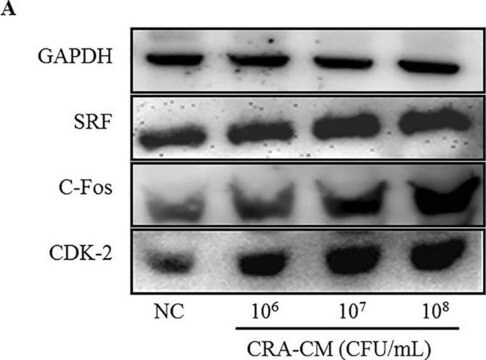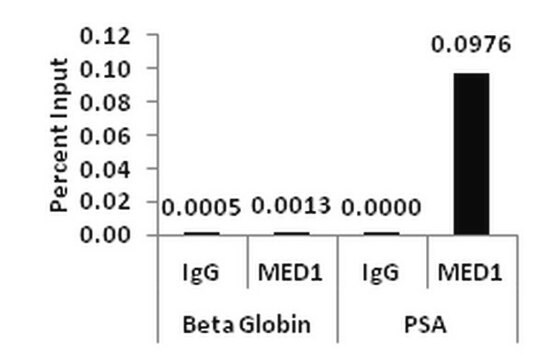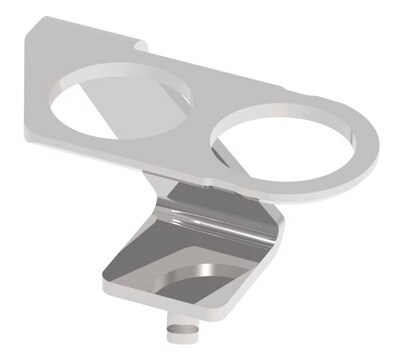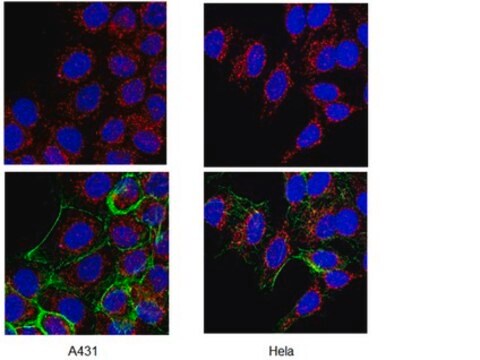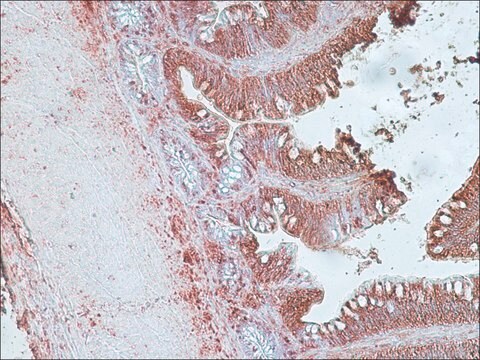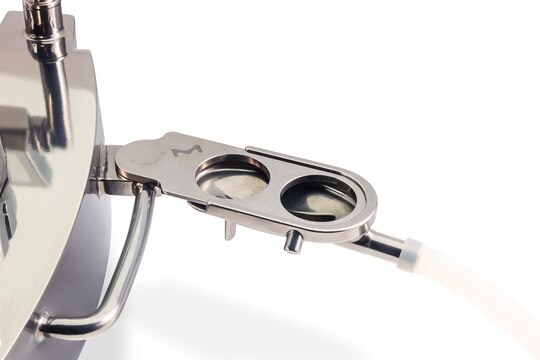17-10111
ChIPAb+ Acetyl-Histone H3 (Lys18) - ChIP Validated Antibody and Primer Set
serum, from rabbit
Sinônimo(s):
H3K18Ac, Histone H3 (acetyl K18)
Faça loginpara ver os preços organizacionais e de contrato
About This Item
Código UNSPSC:
12352203
eCl@ss:
32160702
NACRES:
NA.52
Produtos recomendados
fonte biológica
rabbit
Nível de qualidade
forma do anticorpo
serum
clone
polyclonal
reatividade de espécies
Saccharomyces cerevisiae, yeast, human
reatividade da espécie (prevista por homologia)
vertebrates (most common)
fabricante/nome comercial
ChIPAb+
Upstate®
técnica(s)
ChIP: suitable (ChIP-seq)
dot blot: suitable
western blot: suitable
nº de adesão NCBI
nº de adesão UniProt
Condições de expedição
dry ice
Categorias relacionadas
Descrição geral
All ChIPAb+ antibodies are individually validated for chromatin precipitation, every lot, every time. Each ChIPAb+ antibody set includes control primers (tested every lot by qPCR) to biologically validate your IP results in a locus-specific context. The qPCR protocol and primer sequences are provided, allowing researchers to validate ChIP protocols when using our antibody in their chromatin context. Each set also includes a negative control antibody to ensure specificity of the ChIP reaction.
The ChIPAb+ Acetyl-Histone H3 (Lys18) set includes the Acetyl-Histone H3 (Lys18) antibody, a negative control normal rabbit serum, and control primers which amplify a 166 bp region of human GAPDH promoter. The Acetyl-Histone H3 (Lys18) and negative controls are supplied in a scalable "per ChIP" reaction size and can be used to functionally validate the precipitation of Acetyl-Histone H3 (Lys18) -associated chromatin.
The ChIPAb+ Acetyl-Histone H3 (Lys18) set includes the Acetyl-Histone H3 (Lys18) antibody, a negative control normal rabbit serum, and control primers which amplify a 166 bp region of human GAPDH promoter. The Acetyl-Histone H3 (Lys18) and negative controls are supplied in a scalable "per ChIP" reaction size and can be used to functionally validate the precipitation of Acetyl-Histone H3 (Lys18) -associated chromatin.
Histone H3 is one of the 5 main histone proteins involved in the structure of chromatin in eukaryotic cells. Featuring a main globular domain and a long N terminal tail H3 is involved with the structure of the nucleosomes of the ′beads on a string′ structure.
Acetylation of histone H3 occurs at several different lysine positions in the histone tail and is performed by a family of enzymes known as Histone Acetyl Transferases (HATs).
Acetylation of histone H3 occurs at several different lysine positions in the histone tail and is performed by a family of enzymes known as Histone Acetyl Transferases (HATs).
Especificidade
Recognizes Histone H3 acetylated on lysine 18.
Imunogênio
KLH-conjugated, synthetic peptide (GKAPRAcKQLASK-C) corresponding to amino acids 13-23 of yeast Histone H3 acetylated on lysine 18with a C-terminal cysteine added for conjugation purposes
Aplicação
Chromatin Immunoprecipitation:
Representative lot data.
Sonicated chromatin prepared from HeLa cells (1 X 10E6 cell equivalents per IP) were subjected to chromatin immunoprecipitation using 2 µL of either Normal Rabbit Serum , or 2 µL of Anti-Acetyl-Histone H3 (Lys18)and the Magna ChIP® A Kit (Cat. # 17-610). Successful immunoprecipitation of Acetyl-Histone H3 (Lys18) associated DNA fragments was verified by qPCR using Control Primers specific for the human GAPDH promoter region as a positive locus, and β-globin primers as a negative locus. Data is presented as percent input of each IP sample relative to input chromatin for each amplicon and ChIP sample as indicated.
Please refer to the EZ-Magna ChIP A (Cat. # 17-408) or EZ-ChIP (Cat. # 17-371) protocol for experimental details.
ChIP-Sequencing:
Representative lot data.
Chromatin immunoprecipitation was performed using the Magna ChIP HiSens kit (cat# 17-10460), 2 µg of anti-acetyl-Histone H3 (Lys18) antibody (cat# 17-10111), 20 µL Protein A/G beads , and 1e6 crosslinked HeLa cell chromatin followed by DNA purification using magnetic beads. Libraries were prepared from Input and ChIP DNA samples using standard protocols with Illumina barcoded adapters, and analyzed on Illumina HiSeq instrument. An excess of ten million reads from FastQ files were mapped using Bowtie (http://bowtie-bio.sourceforge.net/manual.shtml) following TagDust (http://genome.gsc.riken.jp/osc/english/dataresource/) tag removal. Peaks were identified using MACS (http://luelab.dfci.harvard.edu/MACS/), with peaks and reads visualized as a custom track in UCSC Genome Browser (http://genome.ucsc.edu) from BigWig and BED files.
Western Blot Analysis:
Representative lot data.
Recombinant histone H3 (lane 1, Catalog # 14-494) and acid extracts from sodium butyrate treated (lane 2) and untreated (lane 3) HeLa cells (Catalog # 17-305) were probed with anti acetyl- Histone H3 (Lys18) (1:10,000 dilution).
Arrow indicates acetyl histone H3 (Lys18) (17 kDa).
Dot Blot:
Representative lot data.
40 ng and 4ng amounts of histone peptides with various modifications (see table 1) were transferred to PVDF membrane and probed with Anti-Acetyl-Histone H3 (Lys18) antibody (1:5000 dilution). Proteins were visualized using a goat anti-rabbit IgG conjugated to HRP and a chemiluminescence detection system. Image from a 60 second exposure is shown.
Representative lot data.
Sonicated chromatin prepared from HeLa cells (1 X 10E6 cell equivalents per IP) were subjected to chromatin immunoprecipitation using 2 µL of either Normal Rabbit Serum , or 2 µL of Anti-Acetyl-Histone H3 (Lys18)and the Magna ChIP® A Kit (Cat. # 17-610). Successful immunoprecipitation of Acetyl-Histone H3 (Lys18) associated DNA fragments was verified by qPCR using Control Primers specific for the human GAPDH promoter region as a positive locus, and β-globin primers as a negative locus. Data is presented as percent input of each IP sample relative to input chromatin for each amplicon and ChIP sample as indicated.
Please refer to the EZ-Magna ChIP A (Cat. # 17-408) or EZ-ChIP (Cat. # 17-371) protocol for experimental details.
ChIP-Sequencing:
Representative lot data.
Chromatin immunoprecipitation was performed using the Magna ChIP HiSens kit (cat# 17-10460), 2 µg of anti-acetyl-Histone H3 (Lys18) antibody (cat# 17-10111), 20 µL Protein A/G beads , and 1e6 crosslinked HeLa cell chromatin followed by DNA purification using magnetic beads. Libraries were prepared from Input and ChIP DNA samples using standard protocols with Illumina barcoded adapters, and analyzed on Illumina HiSeq instrument. An excess of ten million reads from FastQ files were mapped using Bowtie (http://bowtie-bio.sourceforge.net/manual.shtml) following TagDust (http://genome.gsc.riken.jp/osc/english/dataresource/) tag removal. Peaks were identified using MACS (http://luelab.dfci.harvard.edu/MACS/), with peaks and reads visualized as a custom track in UCSC Genome Browser (http://genome.ucsc.edu) from BigWig and BED files.
Western Blot Analysis:
Representative lot data.
Recombinant histone H3 (lane 1, Catalog # 14-494) and acid extracts from sodium butyrate treated (lane 2) and untreated (lane 3) HeLa cells (Catalog # 17-305) were probed with anti acetyl- Histone H3 (Lys18) (1:10,000 dilution).
Arrow indicates acetyl histone H3 (Lys18) (17 kDa).
Dot Blot:
Representative lot data.
40 ng and 4ng amounts of histone peptides with various modifications (see table 1) were transferred to PVDF membrane and probed with Anti-Acetyl-Histone H3 (Lys18) antibody (1:5000 dilution). Proteins were visualized using a goat anti-rabbit IgG conjugated to HRP and a chemiluminescence detection system. Image from a 60 second exposure is shown.
Research Category
Epigenetics & Nuclear Function
Epigenetics & Nuclear Function
Research Sub Category
Histones
Histones
This ChIPAb+ Acetyl-Histone H3 (Lys18) -ChIP Validated Antibody & Primer Set conveniently includes the antibody & the specific control PCR primers.
Embalagem
25 assays per set. Recommended use: ~2 μL of antibody per chromatin immunoprecipitation (dependent upon biological context).
Qualidade
Chromatin Immunoprecipitation:
Representative lot data.
Sonicated chromatin prepared from HeLa cells (1 X 10E6 cell equivalents per IP) were subjected to chromatin immunoprecipitation using 2 µL of either Normal Rabbit Serum, or 2 µL of Anti-Acetyl-Histone H3 (Lys18)and the Magna ChIP® A Kit (Cat. # 17-610). Successful immunoprecipitation of Acetyl-Histone H3 (Lys18) associated DNA fragments was verified by qPCR using Control Primers specific for the human GAPDH promoter region (Figure 1).
Please refer to the EZ-Magna ChIP A (Cat. # 17-408) or EZ-ChIP (Cat. # 17-371) protocol for experimental details.
Representative lot data.
Sonicated chromatin prepared from HeLa cells (1 X 10E6 cell equivalents per IP) were subjected to chromatin immunoprecipitation using 2 µL of either Normal Rabbit Serum, or 2 µL of Anti-Acetyl-Histone H3 (Lys18)and the Magna ChIP® A Kit (Cat. # 17-610). Successful immunoprecipitation of Acetyl-Histone H3 (Lys18) associated DNA fragments was verified by qPCR using Control Primers specific for the human GAPDH promoter region (Figure 1).
Please refer to the EZ-Magna ChIP A (Cat. # 17-408) or EZ-ChIP (Cat. # 17-371) protocol for experimental details.
Descrição-alvo
17 kDa
forma física
Anti-Acetyl-Histone H3 (Lys18) (rabbit polyclonal). One vial of 50 µL of rabbit serum containing 0.05% sodium azide and 30% glycerol. Store at -20°C.
Normal Rabbit Serum. One vial of 100 μL of antiserum containing 0.05% sodium azide. Store at -20°C.
Control Primers, human GAPDH promoter. One vial containing 75 μL of 5 μM each of primer specific for human GAPDH promoter. Store at -20°C.
FOR: TAC TAG CGG TTT TAC GGG CG
REV: TCG AAC AGG AGG AGC AGA GAG CGA
Normal Rabbit Serum. One vial of 100 μL of antiserum containing 0.05% sodium azide. Store at -20°C.
Control Primers, human GAPDH promoter. One vial containing 75 μL of 5 μM each of primer specific for human GAPDH promoter. Store at -20°C.
FOR: TAC TAG CGG TTT TAC GGG CG
REV: TCG AAC AGG AGG AGC AGA GAG CGA
Armazenamento e estabilidade
Stable for 1 year at -20°C from date of receipt. Handling Recommendations: Upon first thaw, and prior to removing the cap, centrifuge the vial and gently mix the solution. Aliquot into microcentrifuge tubes and store at -20°C. Avoid repeated freeze/thaw cycles, which may damage IgG and affect product performance. Note: Variability in freezer temperatures below -20°C may cause glycerol containing solutions to become frozen during storage.
Nota de análise
Control
Includes negative control normal rabbit serum and primers specific for human GAPDH promoter.
Includes negative control normal rabbit serum and primers specific for human GAPDH promoter.
Informações legais
MAGNA CHIP is a registered trademark of Merck KGaA, Darmstadt, Germany
UPSTATE is a registered trademark of Merck KGaA, Darmstadt, Germany
Exoneração de responsabilidade
Unless otherwise stated in our catalog or other company documentation accompanying the product(s), our products are intended for research use only and are not to be used for any other purpose, which includes but is not limited to, unauthorized commercial uses, in vitro diagnostic uses, ex vivo or in vivo therapeutic uses or any type of consumption or application to humans or animals.
Código de classe de armazenamento
10 - Combustible liquids
Certificados de análise (COA)
Busque Certificados de análise (COA) digitando o Número do Lote do produto. Os números de lote e remessa podem ser encontrados no rótulo de um produto após a palavra “Lot” ou “Batch”.
Já possui este produto?
Encontre a documentação dos produtos que você adquiriu recentemente na biblioteca de documentos.
Yan Liang et al.
Bioscience reports, 37(5) (2017-09-25)
Esophageal cancer is one of the leading causes of cancer-related mortality because of poor prognosis. Long noncoding RNAs (lncRNAs) have been gradually demonstrated to play critical roles in cancer development. We identified a novel long noncoding RNA named linc00460 by
Nossa equipe de cientistas tem experiência em todas as áreas de pesquisa, incluindo Life Sciences, ciência de materiais, síntese química, cromatografia, química analítica e muitas outras.
Entre em contato com a assistência técnica